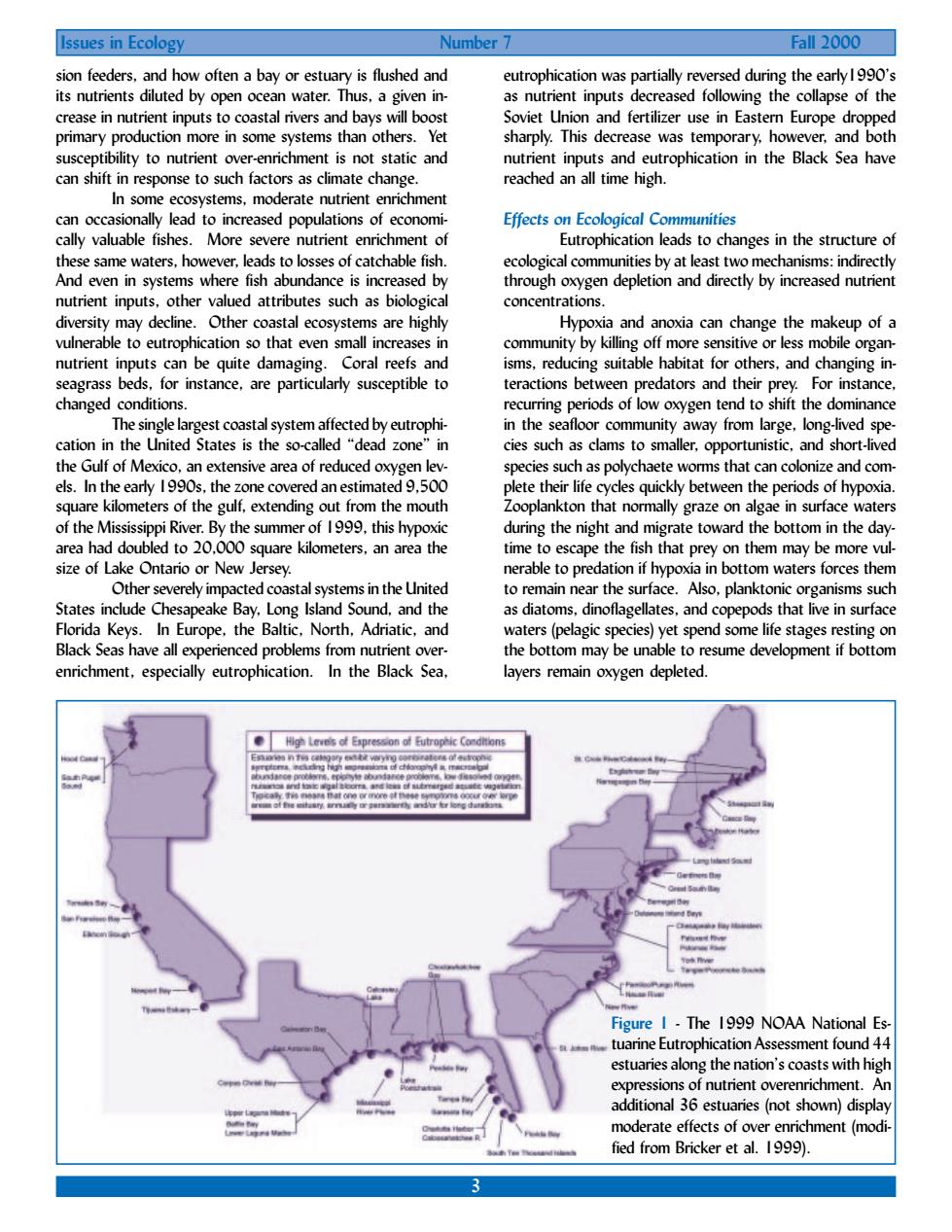正在加载图片...

Issues in Ecology Number Fall 2000 sion feeders.and how often a bay or estuary is flushed and eutrophication was partially reversed during the early i 99o's its nutrients diluted by open ocean water.Thus.a given in as nutrient inputs decreased following the collapse of the inputs to coastal rivers and bays will boost Soviet union and fertilizer use in fastern furon primary production more in some systems than others.Ye susceptibility to nutrient over-enrichment is not static and nutrient inputs and eutrophication in the Black Sea have can shift in response to such factors as climate change reached an all time high. In some ecosystems.moderate nutrient enrichment can occasionally lead to increased populations of economi- Effects on Ecological Communities cally valuable fishes.More severe nutrient enrichment of Eutrophication leads to changes in the structure of these same waters.however.leads to losses of catchable fish. ecological communities by at least two mechanisms:indirectl And even in systems where fish abundance is increased by through oxvgen depletion and directly by increased nutrient nutrient inputs,other valued attributes such as biological concentrations. diversity may decline.Other coastal ecosystems are highly Hypoxia and anoxia can change the makeup of a vulnerable to eutrophication so that even small increases in community by killing off more sensitive or less mobile organ- nutrient inputs can be quite damaging. Coral reefs and isms.reducing suitable habitat for others.and changing in- seagrass beds,for instance.are particularly susceptible to For instance changed conditions. o anc in the away trom large cationi to sm area o els. the an estimat q summer 1999. this hypo on th s in the Unite States include d and the dinoflagellate and that li ope.the Baltic.North.Adriatic.and nd s life st Black Seas have all experienced problems from nutrient over me dov ent if bottom enrichment,especially eutrophication. In the Black Sea Figure I-The 1999 NOAA National Es tuarine Eutrophication Assessment found 44 estuaries along the nation's coasts with high expressions of nutrient overenrichment additional 36 estuaries (not shown)display moderate effects of over enrichment(modi fied from Bricker et al.1999).3 Issues in Ecology Number 7 Fall 2000 sion feeders, and how often a bay or estuary is flushed and its nutrients diluted by open ocean water. Thus, a given increase in nutrient inputs to coastal rivers and bays will boost primary production more in some systems than others. Yet susceptibility to nutrient over-enrichment is not static and can shift in response to such factors as climate change. In some ecosystems, moderate nutrient enrichment can occasionally lead to increased populations of economically valuable fishes. More severe nutrient enrichment of these same waters, however, leads to losses of catchable fish. And even in systems where fish abundance is increased by nutrient inputs, other valued attributes such as biological diversity may decline. Other coastal ecosystems are highly vulnerable to eutrophication so that even small increases in nutrient inputs can be quite damaging. Coral reefs and seagrass beds, for instance, are particularly susceptible to changed conditions. The single largest coastal system affected by eutrophication in the United States is the so-called dead zone in the Gulf of Mexico, an extensive area of reduced oxygen levels. In the early 1990s, the zone covered an estimated 9,500 square kilometers of the gulf, extending out from the mouth of the Mississippi River. By the summer of 1999, this hypoxic area had doubled to 20,000 square kilometers, an area the size of Lake Ontario or New Jersey. Other severely impacted coastal systems in the United States include Chesapeake Bay, Long Island Sound, and the Florida Keys. In Europe, the Baltic, North, Adriatic, and Black Seas have all experienced problems from nutrient overenrichment, especially eutrophication. In the Black Sea, eutrophication was partially reversed during the early1990s as nutrient inputs decreased following the collapse of the Soviet Union and fertilizer use in Eastern Europe dropped sharply. This decrease was temporary, however, and both nutrient inputs and eutrophication in the Black Sea have reached an all time high. Effects on Ecological Communities Eutrophication leads to changes in the structure of ecological communities by at least two mechanisms: indirectly through oxygen depletion and directly by increased nutrient concentrations. Hypoxia and anoxia can change the makeup of a community by killing off more sensitive or less mobile organisms, reducing suitable habitat for others, and changing interactions between predators and their prey. For instance, recurring periods of low oxygen tend to shift the dominance in the seafloor community away from large, long-lived species such as clams to smaller, opportunistic, and short-lived species such as polychaete worms that can colonize and complete their life cycles quickly between the periods of hypoxia. Zooplankton that normally graze on algae in surface waters during the night and migrate toward the bottom in the daytime to escape the fish that prey on them may be more vulnerable to predation if hypoxia in bottom waters forces them to remain near the surface. Also, planktonic organisms such as diatoms, dinoflagellates, and copepods that live in surface waters (pelagic species) yet spend some life stages resting on the bottom may be unable to resume development if bottom layers remain oxygen depleted. Figure 1 - The 1999 NOAA National Estuarine Eutrophication Assessment found 44 estuaries along the nations coasts with high expressions of nutrient overenrichment. An additional 36 estuaries (not shown) display moderate effects of over enrichment (modified from Bricker et al. 1999).��